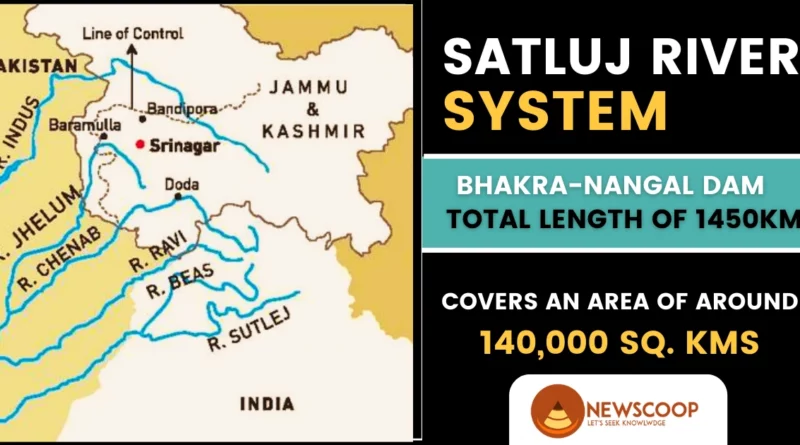Satluj River: Map | Dams & Tributaries
The Satluj River is a major river that flows through several countries in South Asia, including China, India, Nepal, and Pakistan. It has played an important role in the history, culture, and economy of the region, and continues to do so to this day.
The Satluj River is one of the longest and most important rivers in India. It flows through several states including Himachal Pradesh, Punjab, and Haryana, before eventually emptying into the Arabian Sea.
The river has a total length of around 1,450 kilometers and has a major role to play in the lives of millions of people living along its course. It is an important source of water for irrigation, and hydropower generation, and supports a rich variety of flora and fauna in its ecosystem.
| Fact | Detail |
|---|---|
| Length | 1,450 km (900 mi) |
| Source | Rakshastal, Tibet (China) |
| Mouth | Arabian Sea, near Karachi, Pakistan |
| Basin countries | China, India, Nepal, Pakistan |
| Tributaries | Beas River, Spiti River, Rupin River, Baspa River |
| Cities on the river | Shimla, Rampur, Bilaspur, Sundernagar, Mandi |
| Dams on the river | Bhakra Dam, Nangal Dam, Nathpa Jhakri Dam, etc. |
| Importance | Irrigation, hydroelectricity, transportation |
Geographical Features of Satluj River
The following are some points about the geographical features of the Satluj River:
A. Source & Course of the Satluj River:
- The Satluj River originates in the Tibet Autonomous Region of China, near Lake Rakshastal.
- It flows through the Indian state of Himachal Pradesh before entering the Punjab region.
- The Satluj River is the easternmost of the five rivers that flow through the Punjab region of India and Pakistan.
- The river then flows through the states of Haryana and Rajasthan before finally emptying into the Arabian Sea.
- The Satluj River is one of the few rivers in India that flows from east to west, and it has played an important role in connecting the Himalayan region with the rest of India.
B. Major tributaries of the Satluj River:
- The major tributaries of the Satluj River include the Beas, Spiti, and Rupi.
- The Beas River is the largest tributary and joins the Satluj River at Harike in Punjab.
- The Spiti River is a major Right-bank tributary of the Satluj River and flows through the Spiti Valley in Himachal Pradesh.
- The Rupi River is another left-bank tributary that joins the Satluj River near Rampur in Himachal Pradesh.
- The Sutlej Yamuna Link Canal, a controversial canal that links the Satluj River with the Yamuna River, is also a tributary of the Satluj River.
C. Physical characteristics of the Satluj River:
- The Satluj River is around 1,450 kilometers long, making it one of the longest rivers in India.
- It has a total drainage area of around 140,000 square kilometers.
- The river has a wide floodplain and meanders through several valleys and gorges.
- The river has a high gradient and flows through steep slopes in some sections, which makes it ideal for hydropower generation.
- The river’s water is sourced from snowmelt in the Himalayas, and it has a significant impact on the region’s climate and ecology.
- The River has a unique ecology, with several rare and endangered species of fish and other aquatic life.’
D. Map of Satluj River:

Historical Significance
1. Ancient Civilizations along the Satluj River
Harappan civilization: The Satluj River is believed to have played a crucial role in the development of the ancient Harappan civilization, which flourished in the region around 2500 BCE. The river was used for irrigation and transportation, and several Harappan settlements have been excavated along its banks.
Vedic civilization: The Satluj River also features prominently in the Vedic literature, which dates back to around 1500 BCE. The river is mentioned in several hymns and is considered sacred by many communities.
2. Role of the Satluj River in Indian History
Battle of the Satluj River: In 1845, the British East India Company fought a decisive battle against the Sikh Empire near the Satluj River. The battle is significant as it marked the beginning of the First Anglo-Sikh War, which led to the annexation of the Punjab region by the British.
Partition of India: The Satluj River also played a significant role in the partition of India in 1947. The river formed the border between the newly created states of India and Pakistan, and millions of people were displaced from their homes as a result of the partition.
3. Impact of the Satluj River on Local Communities
Cultural significance: The Satluj River has been a source of inspiration for artists, poets, and writers for centuries. It is considered sacred by many communities and is the site of several religious festivals and rituals.
Economic significance: The Satluj River is an important source of water for agriculture and is used for generating hydropower. The river also supports a thriving fishing industry and provides employment opportunities to many people in the region.
Environmental significance: The Satluj River supports a rich and diverse ecosystem, with several species of flora and fauna dependent on its water. However, the river has also been affected by pollution and other environmental issues, which have had a negative impact on the local communities.
Dams on Satluj River
| Dam Name | Location | Height (m) |
|---|---|---|
| Bhakra Dam | Bilaspur and Solan districts, Himachal Pradesh | 226 |
| Nangal Dam | Rupnagar district, Punjab | 29 |
| Nathpa Jhakri Dam | Kinnaur district, Himachal Pradesh | 185 |
| Karcham Wangtoo Dam | Kinnaur district, Himachal Pradesh | 178 |
| Rampur Hydroelectric Project | Shimla district, Himachal Pradesh | 68 |
| Baspa-II Hydroelectric Project | Kinnaur district, Himachal Pradesh | 35 |
Following are the dams on the Satluj River:
- Bhakra Dam
- Nangal Dam
- Nathpa Jhakri Dam
- Karcham Wangtoo Dam
- Rampur Hydroelectric Project
- Baspa-II Hydroelectric Project
1. Bhakra Dam
- It is located on the Satluj River in the Bilaspur district of Himachal Pradesh.
- The dam was completed in 1963 and is one of the largest dams in India, with a height of 226 meters and a length of 518 meters.
- It has a storage capacity of 9.34 billion cubic meters and is used for irrigation, power generation, and flood control.
- The dam has two powerhouses, one on each side of the river. The left bank powerhouse has 6 turbines with a total capacity of 540 MW, while the right bank powerhouse has 5 turbines with a total capacity of 450 MW.
- The electricity generated by the dam is distributed to various states in northern India, including Punjab, Haryana, Himachal Pradesh, and Rajasthan.
2. Nangal Dam
- Nangal is located on the Satluj River in the Rupnagar district of Punjab.
- The dam was completed in 1961 and has a height of 29 meters and a length of 304 meters.
- It is a gravity dam and was built to regulate the flow of the Satluj River and facilitate irrigation in the region.
- The dam has a capacity of 27.5 million cubic meters and can irrigate around 12,000 hectares of land in the region.
- The water released from the dam is also used for drinking water purposes in nearby towns and cities.
- The dam has a power station with two turbines, with a total installed capacity of 70 MW.
- The electricity generated by the dam is used to power nearby cities and towns in the region.
3. Nathpa Jhakri Dam
- It is located on the Satluj River in Himachal Pradesh, near the town of Rampur.
- The dam was completed in 2004 and has a height of 185 meters and a length of 435 meters.
- It is a run-of-the-river hydroelectric project and has a total installed capacity of 1,500 MW, making it one of the largest hydroelectric power plants in India.
- The dam has a concrete gravity design and required the excavation of over 18 million cubic meters of rock and earth.
- The dam has a 27-kilometer-long headrace tunnel that carries water from the reservoir to the power station.
- The electricity generated by the dam is transmitted to various parts of India, including Delhi, Haryana, and Punjab.
4. Karcham Wangtoo Dam
- It is located on the Satluj River in the Kinnaur district of Himachal Pradesh.
- The project was completed in 2012 and is owned by Jaiprakash Power Ventures.
- The dam is a run-of-the-river hydroelectric project, which means that it generates electricity without the need for a large reservoir or lake.
- The installed capacity of the dam is 1,000 MW, making it one of the largest hydroelectric power plants in India.
- The dam is 180 meters high and 520 meters long, and it has a concrete arch design.
- The electricity generated by the dam is transmitted to various parts of India through a network of transmission lines.
- The dam has had some controversies related to environmental and social impacts, including concerns about the displacement of local communities and the impact on the river’s ecology
5. Baspa-II Hydroelectric Project
- It is located on the Baspa River, which is a tributary of the Satluj River, in the Kinnaur district of Himachal Pradesh.
- The project was commissioned in 2010 and has a total installed capacity of 300 MW.
- The project includes a 35-meter high concrete dam, a 7.6 km long headrace tunnel, and an underground powerhouse with three 100 MW turbines.
- The project was built by Jaypee Group, which operates several hydroelectric projects in Himachal Pradesh.
- The electricity generated by the project is transmitted to various parts of India, including Delhi, Haryana, and Punjab.
- The project has had a significant impact on the economy of the region, as it has created employment opportunities and generated revenue for the state government.
Tributaries of Satluj River
The following are the names of some major tributaries of the Satluj River:
- Beas River
- Spiti River
- Rupin River
- Baspa River
Biodiversity of Satluj River
Flora: The River supports a variety of plant species, ranging from submerged aquatic plants to marsh vegetation. Some of the common plant species found in the river include water hyacinth, water lilies, and water lettuce.
Fauna: The River is home to a diverse range of aquatic animals, including several species of fish, turtles, crabs, and mollusks. Some of the common fish species found in the river include catfish, carp, and mahseer.
The following are the names of some important fish species found in the Satluj River:
- Golden Mahseer
- Silver Mahseer
- Schizothorax
- Himalayan Trout
- Catfish
The following are some important non-fish species found in the Satluj River basin:
- Indian Pangolin
- Himalayan Tahr
- Snow Leopard
- Indian Vulture
- Himalayan Musk Deer
Conclusion
In conclusion, the Satluj River is a significant river that holds immense ecological, historical, and economic importance in the region. The river supports a diverse range of flora and fauna, which is crucial for maintaining the local ecosystem.
Further, the river has also played a crucial role in Indian history and has been an important source of livelihood for local communities. The river’s economic significance can be seen in various sectors such as hydropower generation, agriculture, transportation, and tourism.
However, the river is facing several challenges such as pollution, habitat destruction, and climate change, which require urgent attention and intervention. Therefore, there is a need to implement sustainable practices and policies that can help protect and preserve the Satluj River for future generations.
Thank You!
Related Links:

